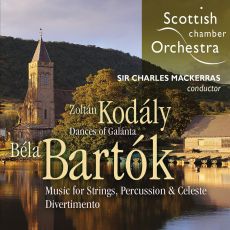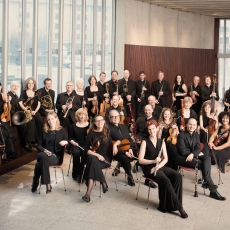Bartok and Kodaly - SCO - Atlanta Audio Society
In more than forty years in recording studios, Sir Charles Mackerras never seems to have made a bad record. On occasion, as in the present program of works by Hungarian composers Bela Bartók and Zoltan Kodály, he pops out a great one. Born in the U.S. of Australian parents, Mackerras studied conducting in Prague with two masters, Vaclav Talich and Karel Ancerl and has conducted in opera houses around the globe over the past four decades. As befits a world traveler, the redhead has shown himself a master of many different periods and styles.
Which brings us to three seminal 20th century Hungarian works. At the helm of the excellent Scottish Chamber Orchestra, Mackerras conducts scintillating performances of Bartók's Music for Strings, Percussion and Celeste and Divertimento for Strings and Kodály's Dances of Galanta. First, the Kodály. Under Mackerras' baton, the orchestra smoothly reels off the seven colorful dances, highly contrasted in rhythm and mood, inspired by Magyar tunes as interpreted by the famous gypsy bands of the district where Galanta is located. (The name "Galanta" may mean nothing to the non-Hungarian, but it is a town on the road from Budapest to Vienna where the army used to hold dances as part of its recruiting.)
Next, Bartók's Music for Strings (et cetera) is given a revealing performance that shows us how the composer opened up new possibilities for the modern orchestra. The work is scored for a double string orchestra separated into two opposing groups, with the other instruments - including harp, piano (used as a percussive instrument), the seldom-heard celeste (of which, more later), kettledrums, xylophone, and a miscellany of percussion under the control of one player - located in the middle. The soundstage in the present SACD optimally preserves the vital three-dimensional spatial relationships Bartók conceived.
The work itself has energy, drama, and a broad dynamic range. Highlights include the four bars of shimmering figuration by the celeste just before the first movement falls away to silence. (The celeste, you may recall, was the "toy" instrument Tchaikovsky used in his Nutcracker in the Dance of the SugarPlum Fairy. Here, its character is quite different, as befits the very serious nature of the music.) Also memorable is the Adagio movement, in which Bartók's unusual sensitivity to the sounds of the night - birds, insects, rustling leaves and grass - is exemplified in a memorable piece of "night music," much as he was later to do in his Third Piano Concerto.
We conclude with the Divertimento for Strings, a work of great intensity and concentration of mood that belies the usual association of "divertimento" with light entertainment. The Adagio, in particular, has a turn of E#-G-F# that is unmistakable in its anguish, perhaps reflecting the composer's grief at news that his mother was seriously ill. The vivacity of the outer movements is of special note in this performance.

